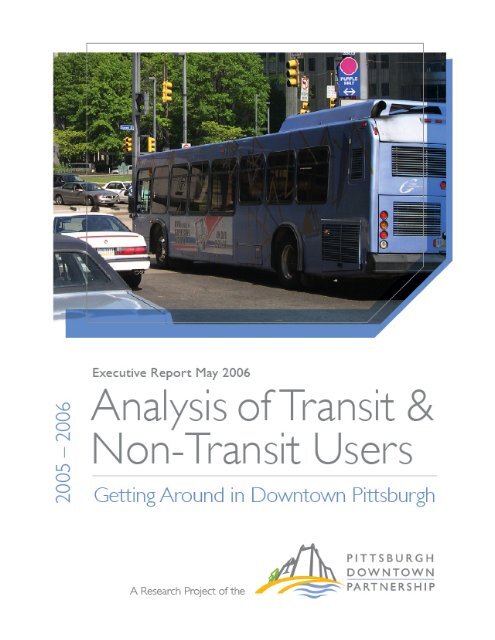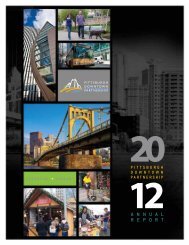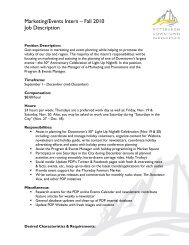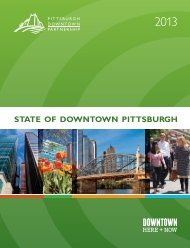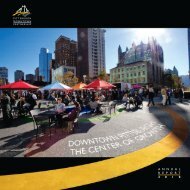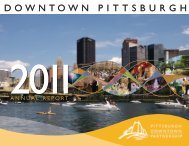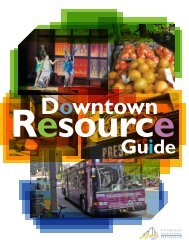Executive Report - The Pittsburgh Downtown Partnership
Executive Report - The Pittsburgh Downtown Partnership
Executive Report - The Pittsburgh Downtown Partnership
Create successful ePaper yourself
Turn your PDF publications into a flip-book with our unique Google optimized e-Paper software.
I. INTRODUCTIONIn June 2005, the <strong>Pittsburgh</strong> <strong>Downtown</strong> <strong>Partnership</strong> (PDP) retained the consultingfirm, Tripp Umbach & Associates (TUA), to complete a comprehensive study of<strong>Downtown</strong> <strong>Pittsburgh</strong> transit and non-transit users. <strong>The</strong> goal of the research was tointerview a cross section of the estimated 200,000 people who either live in <strong>Downtown</strong><strong>Pittsburgh</strong> or who visit <strong>Downtown</strong> <strong>Pittsburgh</strong> daily for employment, business meetings,special events, shopping, and education. For the purposes of this study, <strong>Downtown</strong><strong>Pittsburgh</strong> is defined as including the Golden Triangle, North Shore, StationSquare, Convention Center/Near Strip District, and Uptown.Tripp Umbach developed a detailed survey with input from the PDP and distributedthe survey to six <strong>Downtown</strong> <strong>Pittsburgh</strong> market segments:•People who work in <strong>Downtown</strong> <strong>Pittsburgh</strong>;•People who attend <strong>Downtown</strong> <strong>Pittsburgh</strong> events, including tourists andconventioneers;•People who travel into <strong>Downtown</strong> <strong>Pittsburgh</strong> to participate in business-relatedactivities;•<strong>Downtown</strong> <strong>Pittsburgh</strong> shoppers;•Students at <strong>Downtown</strong> <strong>Pittsburgh</strong> colleges, universities, and trade schools;•<strong>Downtown</strong> <strong>Pittsburgh</strong> residents in the 15219 and 15222 zip codes.Tripp Umbach collected a total of 2,236 surveys from an appropriate sample withineach market segment. <strong>The</strong> collected data is presented in graphs or tables that areidentified as answered either by all respondents or by each market segment.To determine the appropriate sample per market segment, TUA estimated the daily<strong>Downtown</strong> population to be approximately 200,000 people. Based on this estimate,Tripp Umbach collected surveys from the six market segments as shown in Table 1.Table 1: Total Surveys Completed by Six <strong>Downtown</strong> <strong>Pittsburgh</strong> Market Segments<strong>Downtown</strong> MarketSegmentEst. Number ofPeople Per Day in<strong>Downtown</strong>Min. Number ofSurveys to beCompletedTotal SurveysCompletedEmployees 140,000 550 750Visitors to Special Events 25,000 400 415Business Visitors 15,000 350 356Shoppers 10,000 300 315Students 5,000 200 200Residents 5,000 200 200Total 200,000 2,000 2,2362
II.PROJECT OBJECTIVESFrom existing transit users, the PDP was interested in learning the following:•For what purpose(s) do existing transit users need to travel within the <strong>Downtown</strong><strong>Pittsburgh</strong> area?•Do existing transit users also use public transit to get around <strong>Downtown</strong> <strong>Pittsburgh</strong>once they are here?•Are existing transit users aware of the <strong>Downtown</strong> ‘free fare’ transit zone and, if so,do they fully understand it and/or use it?•Do existing transit users believe there are gaps to <strong>Downtown</strong> public transit and, ifso, what are they?•How could <strong>Downtown</strong> public transit services be improved?•In their view, how would existing transit users rate the readability/understandabilityof <strong>Pittsburgh</strong>’s overall transit system?From non-transit riders (both visitors and non-visitors alike), the consultant was askedto assess the following:•What kind of transportation is being used by non-transit users to get into and out of<strong>Downtown</strong> <strong>Pittsburgh</strong>?•For what purpose(s) do non-transit users need to travel within the <strong>Downtown</strong><strong>Pittsburgh</strong> area?•Are non-transit users aware of the different public transit options available forgetting around <strong>Downtown</strong> <strong>Pittsburgh</strong>?•Are non-transit users aware of the <strong>Downtown</strong> ‘free fare’ transit zone and, if so, dothey fully understand it and/or use it?•Do non-transit users believe there are gaps to <strong>Downtown</strong> public transit and, if so,what are they?•How could <strong>Downtown</strong> public transit services be improved?•In their view, how would non-transit users rate the readability/understandability of<strong>Pittsburgh</strong>’s overall transit system?It was anticipated that the process of surveying transit and non-transit users wouldrequire an array of approaches. Whereas some of the data gathering was achievedthrough the utilization of paper and on-line surveys, a majority of the surveyingprocess, especially for new and occasional <strong>Downtown</strong> visitors, required the use ofintercept surveys.III.TRAVEL MODES AND DOWNTOWN PITTSBURGH DESTINATIONSMode of Travel To and From <strong>Downtown</strong> <strong>Pittsburgh</strong>While the main purpose of the study was to evaluate movement within <strong>Downtown</strong><strong>Pittsburgh</strong> once a person has arrived there, the survey asked what mode oftransportation respondents typically use to travel to and from <strong>Downtown</strong> <strong>Pittsburgh</strong>. Asdepicted in Graph 1, most respondents indicated that they commute to <strong>Downtown</strong><strong>Pittsburgh</strong> by driving in a car, whether alone or in a carpool.3
Graph 1: Mode of Travel To and From <strong>Downtown</strong> <strong>Pittsburgh</strong> for All RespondentsDrive alone46.1BusCarpool13.029.0n=2,200"T" (Light Rail)WalkVanpoolBicycleOther6.63.60.50.21.00% 20% 40% 60% 80% 100%<strong>The</strong> next largest category is transit users: 35.6% of the respondents reported that theyuse public transit, either taking the bus (29%) or the ‘T’ (6.6%). Graph 2 below showsthe transit use breakdown by the six different market segments.Graph 2: Analysis by Market Segment of Respondents Who Use Public Transit to Travel To AndFrom <strong>Downtown</strong> <strong>Pittsburgh</strong>Employees38.7Visitors for SpecialEvents15.9Business VisitorsShoppers26.533.2n=2,164Students59.5Residents58.90% 20% 40% 60% 80% 100%4
As can be seen in Graph 2 on the previous page, students, <strong>Downtown</strong> residents, andemployees are the most likely to use public transportation when traveling to and from<strong>Downtown</strong>.Mode of Travel Within <strong>Downtown</strong> <strong>Pittsburgh</strong><strong>The</strong> main purpose of this study was to evaluate modes of travel for people who havealready arrived or have begun their day in <strong>Downtown</strong> <strong>Pittsburgh</strong>. As shown in Graph3, the modes of travel within the <strong>Downtown</strong> <strong>Pittsburgh</strong> area are, for the most part,significantly different than those used to travel to and from <strong>Downtown</strong> <strong>Pittsburgh</strong>.Graph 3: Comparison of Travel Modes between All Respondents Traveling To And From<strong>Downtown</strong> <strong>Pittsburgh</strong> and Those Traveling Within <strong>Downtown</strong> <strong>Pittsburgh</strong>Drive Alone30.746.1Bus16.229.0"T" (LightRail)6.65.7Travel to and from<strong>Downtown</strong> n=2,200Walk3.642.1Travel within <strong>Downtown</strong>n=1,897Other5.314.70% 20% 40% 60% 80% 100%Perhaps surprisingly, more respondents choose to “Drive Alone” than use publictransit when traveling from place to place within <strong>Downtown</strong> <strong>Pittsburgh</strong>. With nearlyone-third of all trips within the <strong>Downtown</strong> core being completed by driving alone, thereis significant opportunity to encourage the use of public transit services for gettingaround <strong>Downtown</strong>. Walking to additional destinations within <strong>Downtown</strong> <strong>Pittsburgh</strong> isclearly the number one preferred transportation option. Further analysis of the dataindicated that <strong>Downtown</strong> employees are the most likely segment to walk to additionaldestinations, with 58.3% making that choice, while visitors to special events are theleast likely to do so, with only 23.8% choosing to walk.On the following page, Graph 4 illustrates that <strong>Downtown</strong> residents and students aremore likely than other segments to continue to use public transportation once they arein <strong>Downtown</strong> and need to travel within the <strong>Downtown</strong> <strong>Pittsburgh</strong> area to otherdestinations.Although <strong>Downtown</strong> employees are the third most likely market segment to use publictransportation when traveling to and from <strong>Downtown</strong> <strong>Pittsburgh</strong>, on the following page,Graph 4 indicates they are least likely to use public transportation to travel within<strong>Downtown</strong> once they have arrived at their workplace.5
Graph 4: Analysis by Market Segment of Respondents Who Use Public Transit When in<strong>Downtown</strong> <strong>Pittsburgh</strong>Employees15.7Visitors forSpecial Events15.8Business VisitorsShoppers18.022.6n=2,164Students37.4Residents46.00% 20% 40% 60% 80% 100%Travel to Other <strong>Downtown</strong> <strong>Pittsburgh</strong> DestinationsGraph 5 shows that travel to additional destinations within <strong>Downtown</strong> <strong>Pittsburgh</strong> isfairly limited for all respondents, with less than one-third of all respondents indicatingthat they travel to other destinations within <strong>Downtown</strong> <strong>Pittsburgh</strong> ‘more than once aweek’.Graph 5: Frequency of Travel by All Respondents to Other Destinations Within <strong>Downtown</strong><strong>Pittsburgh</strong>5 or more times per week10.21 to 4 times per weekA few times a month20.520.8Once a month7.3A few times a year20.4n=2,176Once a year or lessNever9.211.1Other0.50% 20% 40% 60% 80% 100%6
This apparent limited travel between <strong>Downtown</strong> <strong>Pittsburgh</strong> destinations provides anopportunity to promote greater mobility within the <strong>Downtown</strong> core, thereby enhancingthe vitality of the <strong>Downtown</strong> neighborhood.Segmentation analysis, as shown in Graph 6, indicates that <strong>Downtown</strong> students andresidents are most likely to travel to additional destinations within <strong>Downtown</strong><strong>Pittsburgh</strong> ‘one or more times a week’. Visitors to special events and shoppers arethe least likely market segments to travel frequently to additional <strong>Downtown</strong>destinations.Graph 6: Travel by Market Segment to Other <strong>Downtown</strong> <strong>Pittsburgh</strong> Destinations ‘One or MoreTimes a Week’Employees44.7Visitors forSpecial Events7.5Business Visitors15.0Shoppers9.0Students59.3Residents55.10% 20% 40% 60% 80% 100%Important Travel Destinations within <strong>Downtown</strong> <strong>Pittsburgh</strong>Tripp Umbach developed a map that divided <strong>Downtown</strong> <strong>Pittsburgh</strong> into nine distinctneighborhoods. This map, which is displayed on the following page, was provided tothose people completing the survey. <strong>The</strong> respondents were then asked to identifytheir starting <strong>Downtown</strong> neighborhood location, as well as what <strong>Downtown</strong> <strong>Pittsburgh</strong>‘neighborhoods’ they typically travel to during their visits.7
Using data obtained from the survey and also from the outcomes of the <strong>Pittsburgh</strong><strong>Downtown</strong> <strong>Partnership</strong>’s 2004 <strong>Downtown</strong> Circulation Assessment & ImprovementProject, Tripp Umbach analyzed both existing <strong>Downtown</strong> public transit routes and thenumber one destination priorities given by respondents. <strong>The</strong> focus of this particularanalysis effort was to determine potential gaps in <strong>Downtown</strong> <strong>Pittsburgh</strong>’s public transitservices. In instances where the percentage of respondents who “Drive alone to other<strong>Downtown</strong> destinations” was greater than 30%, the TUA data analysts concludedthere is possibly a public transit gap. Clearly, filling the gaps in <strong>Downtown</strong> publictransportation, as highlighted in Table 2 on page9, could play an important role inreducing automobile traffic and congestion.8
Table 2: Potential Gaps in <strong>Downtown</strong> Public TransitStarting Point Ending Point Percentage Who“Drive Alone”Gaps in <strong>Downtown</strong>Public TransitGateway Center Central Core 21%Cultural District Station Square 30% *Convention Center /Near Strip DistrictGrant Street 42% *Central Core Grant Street 20%Grant Street Central Core 24%Uptown Grant Street 25%First Side Central Core 11%Station Square Convention Center /Near Strip District44% *North Shore Station Square 40% *Source: PDP <strong>Downtown</strong> Circulation Assessment & Improvement Project - 2004To determine what destinations are important to users of <strong>Downtown</strong> <strong>Pittsburgh</strong>, thesurvey data was further analyzed to identify those neighborhoods that respondentsconsidered the most important to access. Based on percentages, at the top of the listare the North Shore and Station Square. By contrast, First Side and Uptown are theleast important neighborhood destinations.Graph 7: Most Important Destinations for All Respondents Traveling Within <strong>Downtown</strong> <strong>Pittsburgh</strong>North ShoreStation Square41.338.1Central Core35.6Grant StreetConvention Center/near-Strip District35.334.3n=1,764Cultural District33.6Uptown21.8First Side19.090% 20% 40% 60% 80% 100%
Below, Table 3 lists the <strong>Downtown</strong> destinations that respondents are most interestedin traveling to from their principal <strong>Downtown</strong> <strong>Pittsburgh</strong> starting points. This table alsoreveals the importance of convenient and reliable transit options between the GoldenTriangle and North Shore. As identified earlier in Table 1, the top two marketsegments in terms of the highest estimated number of daily <strong>Downtown</strong> patrons areemployees and visitors to special events. Table 3 illustrates that slightly over one thirdof downtown employees travel to a Golden Triangle destination from a North Shorestarting point. On the other hand, nearly 25% of all visitors to special events typicallystart in the Cultural District neighborhood and travel to a North Shore destination(23.5%). This high degree of travel between the Golden Triangle and North Shore(and vice versa) could possibly present new transit ridership opportunities.Table 3: Principal Starting and Travel Destination Points by Market Segment Within <strong>Downtown</strong><strong>Pittsburgh</strong>Market Segment<strong>Downtown</strong> <strong>Pittsburgh</strong>Starting Point andPercentagesTop Travel DestinationOnce in <strong>Downtown</strong><strong>Pittsburgh</strong><strong>Downtown</strong> Employees North Shore (33.3%) Grant Street (17.5%)<strong>Downtown</strong> Visitors for Events Cultural District (24.8%) North Shore (23.5%)<strong>Downtown</strong> Business Visitors Gateway Center (15.5%) Grant Street (22.3%)<strong>Downtown</strong> Shoppers Central Core (50%) Gateway Center (29.5%)<strong>Downtown</strong> Students First Side (27%) Station Square (29.2%)<strong>Downtown</strong> Residents Uptown (34.4%) Central Core (45%)IV.PERCEIVED BARRIERS TO USE AND PERCEPTIONS OF PUBLICTRANSITTo identify barriers to using public transit while in <strong>Downtown</strong> <strong>Pittsburgh</strong>, participantswere asked to rate potential barriers to using the <strong>Downtown</strong> bus or ‘T’ service on ascale of 1 to 5, where 1=Not a Barrier and 5=Major Barrier. Respondents were alsoasked to rate the importance of various attributes related to the <strong>Downtown</strong> bus or ‘T’service. <strong>The</strong> results of these two survey questions for bus users and non- bus usersare presented in Matrix 1.10
<strong>The</strong> stated criteria on which the following analysis was based is as follows:•Availability of <strong>Downtown</strong> buses and the ‘T’•Cleanliness of <strong>Downtown</strong> buses and the ‘T’•Noise level of buses and the ‘T’•Safety of <strong>Downtown</strong> buses and the ‘T’•Seating availability of <strong>Downtown</strong> buses and the ‘T’•Length of time you spend waiting for <strong>Downtown</strong> buses and the ‘T’•Your familiarity with routes of <strong>Downtown</strong> buses and the ‘T’•Smell of bus fumes (Barrier only)•Absence of bus fumes (Importance only)Transit Barriers and Priorities for Bus and Non-Bus UsersMatrix 1: Perceived Barriers and <strong>The</strong>ir Relative Importance to <strong>Downtown</strong> Bus Users and Non-BusUsersMajorBarrier5BAAs shown in Matrix 1 on the previous page, bus users and non-bus users share similarfeelings that the length of time waiting for <strong>Downtown</strong> buses is both somewhat of abarrier and important. While considered a key barrier for non-bus users, familiarity ofroutes is much less a barrier for existing bus users. However, familiarity of routes isviewed as important by both groups. Generally, bus users and non-bus users agreethat noise levels, smell of bus fumes, and seating availability are not critical barriers totransit service. From an importance perspective, however, these criteria are relativelyimportant issues, especially among bus users. Noise level was rated by non-bususers as only a minimal barrier and having a fairly low priority. In retrospect, thisresult may be due to the interpretation of the survey question; it is now assumed bythe TUA surveyors that survey respondents were rating noise levels on the bus rather11Somewhata Barrier=Bus Users=Non-Bus UsersNot aBarrier13RRIERSQ8Very LowImportanceFamiliarityLength of TimeWaitingLength of TimeWaitingAvailabilityFamiliarityCleanlinessSafety CleanlinessFumesFumes SeatingNoise LevelNoise LevelSeatingSafetyI M P O R T A N C E Q 9Availability1 35MediumImportanceVery HighImportance
than the intended meaning, which was aimed at understanding people’s perceptionsregarding the noise caused by diesel buses on the <strong>Downtown</strong> streets.Also in Matrix 1, it can be noted that, although bus safety is a priority in terms ofimportance to the two respondent groups, it is not perceived, for the most part, asmuch of a barrier to bus users. On the other hand, bus safety was identified by nonbususers as both important and to some extent a barrier to transit use.Transit Barriers and Priorities by ‘T’ and Non-‘T’ Users<strong>The</strong> results of two survey questions related to transit barriers and the importance ofvarious attributes for ‘T’ users and non-‘T’ users are presented in Matrix 2 below.Matrix 2: Perceived Barriers and <strong>The</strong>ir Relative Importance to <strong>Downtown</strong> ‘T’ and Non-‘T’ UsersVery HighBarrierSomewhata Barrier=‘T’ Users=Non-’T’ UsersVery LowBarrier513BARRIERSQ8Very LowImportanceLength ofTime WaitingAvailabilityFamiliaritySafetyCleanlinessNoise LevelSeatingFamiliarityNoiseLevelLength of Time WaitingSafetySeatingCleanlinessAvailabilityI M P O R T A N C E Q 931 5MediumImportanceVery HighImportanceAs shown in Matrix 2, regular ‘T’ users do not believe any of the stated transit-relatedcriteria are major barriers. <strong>The</strong>y do, however, view these criteria as playing animportant role in their decision to utilize Port Authority’s light rail transit (‘T’) system.Not surprisingly, ‘T’ users identified length of time waiting as being important, as wellas the highest rated barrier to LRT use. In contrast, non-‘T’ users rated all but seatingavailability and noise level between ‘somewhat of a barrier’ and a ‘major barrier’. Inthe case of non-‘T’ users, availability of the ‘T’ was identified as slightly more of abarrier than length of time waiting. Familiarity of routes, safety, and cleanliness arealso considered by non-‘T’ users as potential barriers to the use of the ‘T’. In everyinstance, however, none of the criteria received a “medium” or “very high” importancerating by those who currently do not ride the ‘T’.12
Perceptions Of Public Transit Within <strong>Downtown</strong>An important objective of the study was to evaluate various perceptions of publictransportation within <strong>Downtown</strong> <strong>Pittsburgh</strong>. For example, Graph 8 shows that nontransitusers, for the most part, have lower levels of understanding where different busroutes go within the <strong>Downtown</strong> <strong>Pittsburgh</strong> area. Also of note, but not surprising, arethe differences in bus routing awareness among transit users who are <strong>Downtown</strong>residents and those who are business visitors. It is clear from the data presentedbelow that transit users who spend more time in <strong>Downtown</strong> <strong>Pittsburgh</strong>, such asresidents and students, have a greater understanding of bus routes than infrequentvisitors, such as business visitors. <strong>The</strong> exception is employees, who are among themost frequent users of <strong>Downtown</strong> <strong>Pittsburgh</strong>, but who have a relatively lowunderstanding of <strong>Downtown</strong> bus routing.Graph 8: Ratings by Market Segment on the Ease of Understanding Where Different Bus RoutesGo Within <strong>Downtown</strong> <strong>Pittsburgh</strong> (where: 1=Strongly Disagree and 5=Strongly Agree)Employees2.742.76Visitors forSpecial Events3.142.73Business VisitorsShoppers2.662.952.782.79TransitNon-TransitStudents2.332.89Residents2.543.210 1 2 3 4 5As depicted in Graph 9 on the following page, <strong>Downtown</strong> residents and students seemto have the greatest understanding of Port Authority’s numbering system for bothbuses and the ‘T’. What is somewhat surprising, however, is the fact that <strong>Downtown</strong>employees who indicated they use public transit also admitted to only a minimal graspof the transit numbering system. This result can possibly be explained by theassumption that most <strong>Downtown</strong> employees’ knowledge of transit routing numbersmay be limited to only those routes used to get them to and from the workplace.13
Graph 9: Ratings by Market Segment on the Ease of Understanding Port Authority’s NumberingSystem for Buses and the ‘T’ (where: 1=Strongly Disagree and 5=Strongly Agree)Employees2.903.06Visitors forSpecial Events3.003.08Business VisitorsShoppers3.133.163.103.01TransitNon-TransitStudents3.182.80Residents2.713.440 1 2 3 4 5<strong>The</strong> next graph (Graph 10), which is displayed on the following page, addresses thesurvey question related to people being unsure as to where buses are going and,subsequently, making the decision to forego transit use. Understandably, transitexperienced<strong>Downtown</strong> residents are the least afraid to get on a bus despite thepossibility of not fully comprehending its route. On the other hand, visitors to specialevents who identified themselves as transit riders are clearly apprehensive aboutgetting on a bus when they are uncertain of its travel route.In contrast, among the non-transit users, <strong>Downtown</strong> residents expressed the leastconcern (with the only rating below ‘3’) about taking the bus without knowing its exactrouting.14
Graph 10: Ratings by Market Segment on the Fear of Getting on a Bus Because <strong>The</strong>y Are Unsureof Its Destination (where: 1=Strongly Disagree and 5=Strongly Agree)Employees2.653.44Visitors for SpecialEvents3.293.58Business Visitors2.733.44TransitShoppers2.663.52Non-TransitStudents2.543.14Residents2.282.800 1 2 3 4 5When survey respondents were asked about being afraid to get on a bus becausethey did not quite understand how to use the transit system (i.e. when and how muchto pay, etc.), the responses of both transit and non-transit users in all six marketsegments indicated a level of fear at ‘3’ or below on a scale of 1 to 5 (Graph 11).<strong>The</strong>se responses give the impression that <strong>Downtown</strong> transit is, for most people, notparticularly intimidating. However, the fact that, in some market segments, thenumber either slightly exceeded ‘3’ or was approaching the mid-fear level of ‘3’ is anindication that not knowing exactly how the system works may play a role in people’sdecision to not use transit.Graph 11: Ratings by Market Segment on the Fear of Getting on a Bus Because <strong>The</strong>y Don’tUnderstand How to Use the Transit System (where: 1=Strongly Disagree and 5=Strongly Agree)Employees1.912.7Visitors forSpecial Events2.533.04Business Visitors1.92.87TransitShoppers1.92.99Non-TransitStudents1.952.83Residents1.932.08150 1 2 3 4 5
While the perception that public transit is for people of a lower socio-economic statusmay be prevalent in other U.S. urban markets, Graph 12 graphically shows that<strong>Downtown</strong> <strong>Pittsburgh</strong> respondents perceive public transportation as being anappropriate means of travel for all socio-economic classes. In response to thestatement, “I think public transit is for people who can’t afford a car”, both transit andnon-transit users in all six market segments overwhelmingly disagreed. Based on thedata, <strong>Downtown</strong> employees feel most strongly about this. It is interesting to point outthat these current results confirm what was learned from the PDP’s 2003 EmployeeTransportation Needs Assessment – <strong>Pittsburgh</strong>ers from a wide range of differentincome levels view public transit as an acceptable transportation option and, therefore,utilize it as a reasonable means of travel.Graph 12: Ratings by Market Segment on the Perception that Public Transit Is for People WhoCan’t Afford a Car (where: 1=Strongly Disagree and 5=Strongly Agree)Employees1.631.98Visitors for SpecialEvents2.172.38Business VisitorsShoppers1.932.361.742.26TransitNon-TransitStudents1.882.13Residents2.312.110 1 2 3 4 5V. AWARENESS OF THE DOWNTOWN ‘FREE FARE’ TRANSIT ZONEAn important component of the Transit / Non-Transit User Survey was the focusplaced on the ‘free fare’ transit zone and the <strong>Downtown</strong> public’s knowledge of itsboundaries and other programmatic characteristics. PDP staff wanted to test theirassumption that only a limited number of people in <strong>Downtown</strong> <strong>Pittsburgh</strong> fullyunderstand the parameters of the zone. <strong>The</strong>refore, Tripp Umbach included a varietyof questions about the ‘free fare’ transit zone on the survey, which allowed theresearch team to quantify respondents’ levels of awareness, understanding, and useof the free <strong>Downtown</strong> service. <strong>The</strong> following map outlines the boundaries of thecurrent ‘free fare’ transit zone in <strong>Downtown</strong> <strong>Pittsburgh</strong>.16
As shown in Graph 13 below, more than half of all non-transit users in <strong>Downtown</strong><strong>Pittsburgh</strong> are unaware of the ‘free fare’ transit zone. Surprisingly, more than one infour (or over 25%) current transit users are also not aware of the ‘free fare’ transitzone.Graph 13: Awareness by All Respondents of the <strong>Downtown</strong> ‘Free Fare’ Transit Zone100%80%74.260%40%44.825.855.2TransitNon-Transit20%170%YesNo
When determining the level of awareness by market segment, Graph 14 below showsthat <strong>Downtown</strong> residents are most aware of the ‘free fare’ transit zone with 77.5%reporting knowledge of the free transit service, while visitors to special events are theleast aware, with only 37.9% reporting knowledge of it. Not too surprisingly,employees have the second highest level of awareness of the ‘free fare’ transit zoneamong all six <strong>Downtown</strong> market segments.Graph 14: Awareness by Market Segment of the ‘Free Fare’ Transit Zone100%80%77.560%40%66.633.462.038.045.554.539.460.6 62.137.9YesNo20%22.50%Resident Employees Student BusinessVisitorsShoppersVisitors forEventsWhile awareness of the zone is fairly high, there is a limited understanding of thespecifics of its use. As depicted in the next graph (Graph 15), only 1.7% of allrespondents are aware that the ‘free fare’ transit zone includes both <strong>Downtown</strong> busand ‘T’ service and that there are time restrictions for buses, but not for the ‘T’.In response to the survey’s open-ended question about how the ‘free fare’ transit zoneworks, 64% of the respondents correctly indicated, however, that both bus and ‘T’ areincluded in the free service. In contrast, 18.5% of all respondents either had no ideaabout the zone or clearly misunderstood its programmatic parameters. Key areas ofmisunderstanding included: “assuming that the zone encompasses the entire City of<strong>Pittsburgh</strong>” and “believing that the zone extends to Station Square”.18
Graph 15: Level of Understanding by All Respondents of the Programmatic Parameters of the‘Free Fare’ Transit ZoneUnderstand Fully1.7Understand Buses and T64.0Understand Buses Only6.6n=1,0Understand T Only9.2Don't know/Misunderstood how it works18.50% 20% 40% 60% 80% 100%Below, Graph 16 shows data for only respondents who have used the ‘free fare’ transitzone at least once. It is important to note that, while the service is free, less than 20%of the people who have ever taken advantage of the ‘free fare’ zone report using it asfrequently as ‘one or more times a week’. On the other hand, more than half of allreported users said they use it ‘a few times a year or less’.Graph 16: Frequency of Use by All Respondents Who Have Used the ‘Free Fare’ Transit Zone5 or more times/week7.51-4 times/week11.1A few times a month18.0Once a month7.3A few times a year30.8Once a year or less21.0other4.30% 20% 40% 60% 80% 100%19
In looking at the market segment breakdown in Graph 17 of frequent ‘free fare’ transitzone users (those who reported using it one or more times a week), 22.4% areresidents and 18.8% are students. Not unexpectedly, visitors to special events are theleast likely group to be frequent users of the zone, coming in at only 5.7%. It isimportant to note, however, that even though employees are the single largest marketsegment included in the study, only 12.6% reported use of the free service one ormore times a week.Graph 17: Frequent ‘Free Fare’ Transit Zone Use by Market Segment (where: ‘Frequent’ is one ormore times a week)Employees12.6Visitors for SpecialEvents5.7Business Visitors6.7Shoppers8.8Students18.8Residents22.40% 20% 40% 60% 80% 100%As shown in Graph 18, out of those respondents who indicated they take advantage ofthe ‘free fare’ transit zone, a higher percentage of users said their travel modepreference is the ‘T’. Relatively few ‘free fare’ transit zone users, in fact, reported thatthey use both the bus and ‘T’ equally.Graph 18: Travel Mode Preference (‘T’, Bus, or Both) of All Respondents Who Use the ‘Free Fare’Transit Zone100%.80%60%40%47.537.1'T' OnlyBus OnlyBoth Bus and 'T' Equally20%15.4200%'T' Only Bus Only Both Bus and 'T'Equally
To those respondents who had never heard of the ‘free fare’ transit zone, thesurveyors briefly described the zone, its boundaries, and programmatic parameters.<strong>The</strong> respondents were then asked how likely it was that they would take advantage ofthis free service now that it had been described to them. Based on the responses(and as displayed in Graph 19), only 29.4% of those who were previously unaware ofthe service indicated they would be “likely” or “very likely” to use it. On the other hand,40.8% responded they would “not likely use it” or would “never use it”.Graph 19: Likelihood of ‘Free Fare’ Transit Zone Use by All ‘Unaware’ Respondents AfterLearning About ItVery Likely13.8Likely15.6Somewhat likely29.9Not Likely28.3Will never use12.50% 20% 40% 60% 80% 100%Further analysis indicates that <strong>Downtown</strong> residents are most likely to consider usingthe ‘free fare’ transit zone after becoming aware of it, with 33.3% indicating that theywould be “Very Likely” to use the zone. Again, <strong>Downtown</strong> employees are the leastlikely to be motivated to use the ‘free fare’ transit zone after it has been explained tothem, with only 7.7% indicating that they would be “very likely” to use the zone.For respondents who recently learned of the ‘free fare’ transit zone and expressed aninterest in using it, a large percentage (55.6%) was interested in using both the busand ‘T’ equally. For respondents who were unaware of the “free fare” zone and arenow interested in using it, slightly more are interested in using the bus only (24.4%)versus the ‘T’ only (19.9%).VI.WAYS DOWNTOWN PITTSBURGH TRANSIT CAN BE IMPROVEDParticipants were given the opportunity to indicate what improvements they wouldmake to the <strong>Downtown</strong> <strong>Pittsburgh</strong> bus and ‘T’ service, based on a set list of responsesprovided on the survey. <strong>The</strong> survey respondent was instructed to ‘check all thatapply’.21
Most, but not all of the response options, relate to the ‘free fare’ transit zone. <strong>The</strong>answer options were as follows:•Expand the ‘free fare’ transit zone to the North Shore•Expand the ‘free fare’ transit zone to the South Shore•Expand the ‘free fare’ transit zone to the Near-Strip District•Expand the ‘free fare’ transit zone to Uptown•Extend the ‘free fare’ transit zone bus hours beyond 7:00 p.m.•Modify the bus routes to provide better <strong>Downtown</strong> circulation•Color-code buses and bus stop signage to identify routes within <strong>Downtown</strong><strong>Pittsburgh</strong><strong>The</strong> data, as reported in Graph 20, includes the multiple responses from this particularsurvey question. After analyzing the responses, the improvement checked by thegreatest percentage (58.7%) of respondents is “Expanding the ‘free fare’ transit zoneto the North Shore”. Not far behind (at 57.9%) was the suggested improvement,“Color-code buses and bus stop signage to identify routes within <strong>Downtown</strong><strong>Pittsburgh</strong>”.Graph 20: Suggested Improvements by All Respondents for <strong>Downtown</strong> <strong>Pittsburgh</strong> Bus and ‘T’ServicesExpand FFTZ to North Shore58.7Expand FFTZ to South Shore44.5Expand FFTZ to Near-Strip District55.5Expand FFTZ to Uptown30.9Extend FFTZ hours beyond 7:00 PMModify bus routes40.737.4n=1Color-Code buses/signage to identify routes57.90% 20% 40% 60% 80% 100%Taking a closer look at the market segment breakdown in terms of suggested transitimprovements, Table 4 shows the number one improvement proposed by each of thesix market segments. Reiterating that, in this study, <strong>Downtown</strong> <strong>Pittsburgh</strong> is definedas including the Golden Triangle, North Shore, Station Square, ConventionCenter/Near Strip District and Uptown, it can be seen that employees and studentsagree that “Expanding the ‘free fare’ transit zone to the North Shore” would improveoverall <strong>Downtown</strong> transit. This is not too surprising, especially given the fact thatemployees, residents, and students are the largest users of transit among the six22
market segments. By the same token, visitors to special events, business visitors,and shoppers are the survey respondents who typically only utilize public transitoccasionally. <strong>The</strong> number one improvement identified by these three marketsegments is “Color-code buses and bus stop signage to identify routes within<strong>Downtown</strong> <strong>Pittsburgh</strong>”.Table 4: Suggested Improvements by Market Segment for <strong>Downtown</strong> <strong>Pittsburgh</strong> Bus and ‘T’ServicesSegmentTopImprovementEmployeesExpand FFTZ to North ShoreVisitors to Special EventsBusiness VisitorsShoppersStudentsColor-code buses and bus stop signage toidentify routes within <strong>Downtown</strong> <strong>Pittsburgh</strong>Color-code buses and bus stop signage toidentify routes within <strong>Downtown</strong> <strong>Pittsburgh</strong>Color-code buses and bus stop signage toidentify routes within <strong>Downtown</strong> <strong>Pittsburgh</strong>Expand FFTZ to North ShoreResidentsExpand FFTZ to UptownGiven that the <strong>Downtown</strong> residents surveyed encompassed those living in zip codes15219 and 15222, it is likely that a number of returned paper surveys came frompeople residing in Uptown and the Lower Hill District and not specifically in <strong>Downtown</strong>proper. This assumption may account for the top transit improvement cited byresidents as being “Expand the ‘free fare’ transit zone to Uptown’.After the study participants identified their preferred <strong>Downtown</strong> <strong>Pittsburgh</strong> transitimprovements, they were asked if they would support an expanded ‘free fare’ transitzone throughout <strong>Downtown</strong> <strong>Pittsburgh</strong>. <strong>The</strong> responses are shown on the followingpage in Graph 21. Not surprisingly, all six market segments - transit and non-transitusers alike - strongly support an expansion of this free service.23
Graph 21: Support by Market Segment for Expanding the ‘Free Fare’ Transit Zone Throughout<strong>Downtown</strong> <strong>Pittsburgh</strong> (where: 1 = Strongly Disagree and 5 = Strongly Agree)EmployeesVisitors forSpecial Events4.104.264.314.08Business VisitorsShoppers4.204.264.104.14TransitNon-TransitStudents4.113.92Residents4.313.920 1 2 3 4 5VII.TRANSIT / NON-TRANSIT USER SURVEY CONCLUSIONS ANDRECOMMENDATIONSTravel Modes and <strong>Downtown</strong> <strong>Pittsburgh</strong> Destinations•<strong>The</strong> highest percentage of all respondents – 46.1% - “drive(s) alone” into and out of<strong>Downtown</strong>. <strong>The</strong> second highest percentage – 35.6% - identified public transit astheir mode of travel into and out of <strong>Downtown</strong>. However, when the data fromspecific market segments are examined, overwhelming majorities of students(59.5%) and residents (58.9%) of <strong>Downtown</strong> choose public transit as their mode oftransport into and out of <strong>Downtown</strong>. <strong>The</strong> third largest market segment with acomparatively high public transit use of 38.6% is <strong>Downtown</strong> employees. 1 <strong>The</strong>sethree market segments also have high percentages of members who reportcoming into <strong>Downtown</strong> <strong>Pittsburgh</strong> 5 or more times a week: employees (93.9%);students (69%); and residents (43.9%).→Students, residents, and employees represent a significant marketingopportunity for increasing public transit use.1 This percentage of public transit use for employees is significantly lower than that documented in thePDP’s 2003 Employee Transportation Needs Assessment, which identified 48% of <strong>Downtown</strong>employees as using public transit One explanation for this difference is that the 2003 survey usedcontrols to ensure that surveys were received from each of the nine <strong>Downtown</strong> neighborhoods andfrom each sector of the <strong>Downtown</strong> economy. <strong>The</strong> 2006 Transit/Non-Transit User Survey did not useany of those controls. Instead, businesses were contacted and asked to share the 2006 survey withtheir employees who then chose whether or not to respond.24
•Once <strong>Downtown</strong>, walking is the number one mode of travel within <strong>Downtown</strong><strong>Pittsburgh</strong> for all respondents. This is a reasonable choice given the small size of<strong>Pittsburgh</strong>’s <strong>Downtown</strong>. However, the second mode of travel within <strong>Downtown</strong>chosen by respondents is driving their own car rather than using public transit.This choice is a concern, particularly since Port Authority operates its ‘free fare’transit zone in <strong>Downtown</strong> and both bus and “T” service are free within specifiedboundaries.→Marketing of the ‘free fare’ transit zone can promote the use of publictransit as a quick and efficient way to get around <strong>Downtown</strong> <strong>Pittsburgh</strong>.•While some market segments, such as students (37.4%) and downtown residents(46%), have high rates of public transit use when traveling within the <strong>Downtown</strong>area, employees are the least likely to use public transit when traveling within<strong>Downtown</strong> <strong>Pittsburgh</strong>. Only 15.7% report using public transit within <strong>Downtown</strong>even though over 69% of employees report traveling to another destination in<strong>Downtown</strong> a few times a month or more.→With the high number of <strong>Downtown</strong> employees in <strong>Downtown</strong> daily and thefrequency with which they travel within <strong>Downtown</strong>, there is clearly a greatopportunity to increase transit participation among this market segment.•<strong>The</strong> North Shore is the most desired destination within Greater <strong>Downtown</strong> <strong>Pittsburgh</strong>for all respondents, followed in declining order by Station Square, the CentralCore, Grant Street, Convention Center/Near Strip District, Cultural District,Gateway Center, Uptown, and First Side. When examined by market segment,employees and business visitors select the North Shore as their top desireddestination, possibly because of the cheaper parking available there. Shoppers,students, and visitors for events select Station Square for their top choice, againpossibly because of the availability of cheaper parking as well as the entertainmentand shopping venues located there.→At the present time, the top two desired destinations within <strong>Downtown</strong><strong>Pittsburgh</strong> - the North Shore and Station Square – are outside theboundaries of the ‘free fare’ transit zone. One solution that wouldaccommodate the needs of <strong>Downtown</strong> <strong>Pittsburgh</strong> patrons is to expand the‘free fare’ transit zone to include both the North Shore and Station Square.•<strong>The</strong> answers to the question, “how do you typically get to these other destinations”,reveal the difficulty of using existing public transit bus routes to get to some of thedesired destinations. Respondents said they “drive alone” to get from theConvention Center/Near Strip District to Grant Street (42%); from the North Shoreto Station Square (47%); and from Station Square to the Convention Center/NearStrip District (50%).→Modify existing bus routes to incorporate point-to-point desired destinationswithin <strong>Downtown</strong> <strong>Pittsburgh</strong>.25
Perceived Barriers to Use and Perceptions of Public Transit•For non-bus users, “lack of familiarity with <strong>Downtown</strong> bus routes” is the greatestbarrier to choosing public transit. Attention to making bus routes more easilyunderstood by the public is needed if transit ridership is to increase. For example,visitors to special events represent a special category of <strong>Downtown</strong> user who visit<strong>Downtown</strong> infrequently but, when they do, it is in numbers that can have adisproportional impact on traffic flow if they enter <strong>Downtown</strong> during the morning orevening weekday rush hour. <strong>The</strong>y are also the group who use public transit theleast and are most likely to use their own car when traveling to additional<strong>Downtown</strong> destinations. And they are especially put off by the existing <strong>Downtown</strong>bus routing and numbering systems.→Create a series of clear, simple color-coded transit corridors to makeexisting <strong>Downtown</strong> bus routes easily comprehensible. Use brochures,<strong>Downtown</strong> transit maps, and color-coded bus stop signs to conveyinformation to such target audiences as downtown employees, visitors,shoppers, students and residents.•By contrast, of the three market segments with high public transit use (students,residents, and employees) two segments – students and residents - regard “lengthof time waiting for the bus” as their biggest barrier to use and employees regard“lack of familiarity with <strong>Downtown</strong> bus routes’ as their biggest barrier. In terms ofimportance, employees rate “bus and ‘T’ availability” and “length of time waiting fora bus” as most important. Students rate “length of time waiting for the bus and ‘T’“as most important; and residents rate “bus availability” and “’T” noise level asmost important.→<strong>The</strong> issues of “availability” of service and “length of time waiting” for eitherthe bus or the ‘T’ speak to frequency of public transit service. In terms ofPort Authority’s present system of operations, there is a high frequency ofservice during the two workday rush hours and reduced service in non-rushhours and on the weekends. For those who use public transit within<strong>Downtown</strong>, frequency of service on both the bus and “T” is of greatimportance. In fact, Port Authority’s largest market segment – <strong>Downtown</strong>employees - who only use public transit to get into and out of <strong>Downtown</strong>,perceive “lack of familiarity with <strong>Downtown</strong> bus routes” as their biggestbarrier to public transit use but “availability of bus and ‘T’” service” as theirmost important issue. One solution is to implement a <strong>Downtown</strong> circulatorthat provides greater frequency of service during the week in non-rushhours.•While public transit in other U.S. urban markets is often perceived as thetransportation option only for people of lower socio-economic status, <strong>Pittsburgh</strong>ersoverwhelmingly reject that characterization of <strong>Pittsburgh</strong>’s public transit ridershipand see it as an appropriate means of travel for people of all socio-economicclasses. In fact, the higher the frequency of coming into <strong>Downtown</strong> by a particularmarket segment, the higher the percentage of respondents who disagreed with thestatement “I think public transit is for people who can’t afford a car.”→In <strong>Pittsburgh</strong>, the lack of negative stigma attached to public transit useprovides transit companies with a marketing opportunity to increase26
idership by focusing on the positive benefits of public transit without havingto counteract damaging stereotypes.Awareness of the <strong>Downtown</strong> ‘Free Fare’ Transit Zone•<strong>Downtown</strong> employees are the market segment most likely to be aware of the ‘freefare’ transit zone, while at the same time being the least likely to use it.Employees are also the least likely to be motivated to use the ‘free fare’ transitzone after it has been explained to them – with only 7.7% indicating that theywould be “very likely” to use the zone.→Since the majority of the daily <strong>Downtown</strong> population is made up ofemployees, outreach to employers and their employees is a key strategy toincrease the use of public transit in Greater <strong>Downtown</strong> <strong>Pittsburgh</strong>.•Overall usage of the ‘free fare’ transit zone is low, with only 1 in 5 respondents usingthe free zone at least weekly. For example, only 12.6% of all employees, thesingle largest market segment with over 93% coming into <strong>Downtown</strong> 5 or moretimes a week, use the ‘free fare’ transit zone at least once per week.→→Pro-actively direct information about use of the ‘free fare’ transit zone toemployers and their employees, including both transit and non-transit userssince nearly half of all employees use transit to travel to and from<strong>Downtown</strong> <strong>Pittsburgh</strong>.Develop and execute a marketing program to promote the use of the ‘freefare’ transit zone for <strong>Downtown</strong> circulation. In addition, promoteinformation on how the existing ‘free fare’ transit zone operates, since lessthan 2% of people who travel within <strong>Downtown</strong> <strong>Pittsburgh</strong> fully understandthe programmatic elements.•Port Authority’s bus routing system efficiently delivers and distributes riders to<strong>Downtown</strong> <strong>Pittsburgh</strong> and then efficiently picks them up and takes them out of<strong>Downtown</strong> on a daily basis. However, based on the minimal use of the ‘free fare’transit zone within <strong>Downtown</strong>, the <strong>Downtown</strong> transit system does not offer efficientservice for point- to-point circulation within the Golden Triangle and the Greater<strong>Downtown</strong> area.→Develop a more comprehensive <strong>Downtown</strong> circulation system using theexisting bus routes as a base and make the necessary route adjustmentsto provide efficient and effective point-to-point circulation within the GoldenTriangle and throughout the Greater <strong>Downtown</strong> area.27
Ways <strong>Downtown</strong> <strong>Pittsburgh</strong> Transit Can Be Improved•When asked what improvements to public transit service within <strong>Downtown</strong> <strong>Pittsburgh</strong>they would like, respondents chose the following as their top three improvements:Expand the ‘free fare’ transit zone to North Shore (58.7%); Color-code buses andsignage to identify routes (57.9%); Expand the ‘free fare’ transit zone to the NearStrip District (55.5%). When examined by market segment, however, it becomesclear that those who use public transit regularly have different needs from thosewho use it occasionally. Employees, students, and residents – all segments with ahigh percentage of public transit use – have as their top improvement theexpansion of the ‘free fare’ transit zone to another neighborhood. Those whocome into <strong>Downtown</strong> infrequently – business visitors, shoppers, and visitors tospecial events – all chose “color-code buses/signage to identify routes” as their topimprovement.→Port Authority personnel have often stated that their routing and signagesystem is easy to understand once an individual uses it regularly.However, the majority of <strong>Downtown</strong> users, even those in market segmentswith high public transit use, do not regularly use public transit either to getinto/out of <strong>Downtown</strong> or to get around <strong>Downtown</strong>. To increase ridership,the goal should be to make the existing public transit system as transparentand accessible as possible to the public. A first step in accomplishing thatgoal is to color-code buses and signage to make their routes easilyidentifiable to any potential user.VIII.IN SUMMARYPort Authority’s current routing system is a hub and spoke system with <strong>Downtown</strong><strong>Pittsburgh</strong> as the hub. Based on this transit routing design, the vast majority of PortAuthority bus routes come into <strong>Downtown</strong>, loop through the central core, and then goout of <strong>Downtown</strong> along the same route in which they arrived. <strong>Downtown</strong> <strong>Pittsburgh</strong> isalso the primary destination point for Port Authority’s light rail or ‘T’ system, with fourLRT stations located throughout <strong>Downtown</strong>.For the City of <strong>Pittsburgh</strong> and its surrounding Allegheny County suburbs, PortAuthority plays a major role in getting people into and out of <strong>Downtown</strong> <strong>Pittsburgh</strong>.<strong>The</strong> questions posed by the Transit / Non-Transit User Survey were seeking answersregarding the travel options and preferences of <strong>Downtown</strong> employees, tourists,conventioneers, business visitors, shoppers, students, and residents once they are in<strong>Downtown</strong>.<strong>The</strong> purpose of this <strong>Executive</strong> <strong>Report</strong> was to provide a comprehensive summary ofhow <strong>Downtown</strong> <strong>Pittsburgh</strong> patrons perceive and use Port Authority’s transit system forthe purposes of getting around <strong>Downtown</strong>, which was defined to include the GoldenTriangle, North Shore, Station Square, Convention Center/Near Strip District, andUptown.28
<strong>The</strong> Transit / Non-Transit User Survey results discussed in this report were based, forthe most part, on responses from all respondents. In several cases, however, theresponses from individual market segments were also presented as a means ofhighlighting similarities and dissimilarities of perception and need by the six identifiedcategories of <strong>Downtown</strong> patrons. Due to the extensiveness of the market segmentdata collected, it was not possible to include these segmented results in their entiretyin the <strong>Executive</strong> <strong>Report</strong>. This information is available in presentation form and will beused by the PDP and others to show comparisons regarding transit-relatedperceptions and needs by the distinct surveyed groups.As <strong>Downtown</strong> <strong>Pittsburgh</strong> continues to evolve into “one of America’s great urbancenters”, the completion of the PDP’s Transit / Non-Transit User Survey presents anunprecedented opportunity for the City of <strong>Pittsburgh</strong>, Allegheny County, Port Authority,and others to consider the most up-to-date perspectives of the <strong>Downtown</strong> publicregarding current transit options for getting around <strong>Downtown</strong>. And, based on theseperspectives, there is yet another opportunity to design and implement carefullyplanned transit system changes by Port Authority that are aimed at enhancing its dayto-daytransit operations and overall ridership.29


